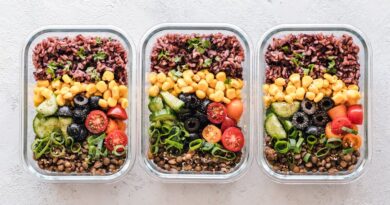Quick Meals for Busy Lifestyles and Pain Management
How Can You Balance a Hectic Schedule with Healthy Eating?

Are you constantly on the go, juggling work, family, and other responsibilities? Finding time to cook balanced meals can be a challenge. But with a few simple tips and tricks, you can whip up quick and nutritious meals that also help manage pain.
Why Is Eating Well Important for Pain Management?

Did you know that certain foods can either aggravate or alleviate pain? By choosing the right ingredients, you can reduce inflammation and discomfort in your body. This is crucial for managing chronic pain conditions and promoting overall wellness.
What Are Some Easy Meal Ideas for Busy Days?

Let’s dive into some quick meal ideas that are not only easy to prepare but also beneficial for pain management:
1. Smoothie Bowls

Blend your favorite fruits and vegetables with some protein-rich Greek yogurt or plant-based protein powder. Top with nuts, seeds, and a drizzle of honey for a delicious and nutritious meal in a bowl.
2. Quinoa Salad
Cook quinoa according to package instructions and mix with chopped veggies like cucumber, bell peppers, and cherry tomatoes. Add a can of drained and rinsed chickpeas for plant-based protein. Drizzle with olive oil and lemon juice for a refreshing meal.
3. Stir-Fry with Tofu
Saut tofu cubes with your favorite veggies like broccoli, bell peppers, and snap peas. Add a splash of soy sauce and some minced garlic for flavor. Serve over brown rice for a filling and nutritious meal.
4. Overnight Oats
Mix oats with milk or yogurt in a jar and let it sit in the fridge overnight. In the morning, top with fruits, nuts, and a drizzle of maple syrup for a quick and satisfying breakfast or snack.
How Can You Incorporate Anti-Inflammatory Foods into Your Meals?
Foods like fatty fish, leafy greens, berries, nuts, and seeds are known for their anti-inflammatory properties. By including these ingredients in your meals, you can help reduce pain and inflammation in your body. Here are some simple ways to incorporate them:
1. Add Flaxseeds to Your Smoothies
Flaxseeds are rich in omega-3 fatty acids, which have been shown to reduce inflammation. Simply sprinkle a tablespoon of ground flaxseeds into your morning smoothie for an extra anti-inflammatory boost.
2. Snack on Mixed Berries
Berries like blueberries, strawberries, and raspberries are packed with antioxidants that help fight inflammation. Keep a container of mixed berries in your fridge for a quick and healthy snack between meals.
3. Cook Salmon for Dinner
Salmon is a great source of omega-3 fatty acids and vitamin D, both of which have anti-inflammatory properties. Pan-sear or bake a fillet of salmon for a delicious and nutritious dinner option.
What Are Some Tips for Meal Planning and Prep?
Meal planning and preparation can save you time and ensure you have healthy meals ready to go. Here are some tips to help you stay organized and on track:
1. Make a Weekly Meal Plan
Sit down at the beginning of each week and plan out your meals. This can help you avoid last-minute decisions and ensure you have all the necessary ingredients on hand.
2. Prep Ingredients in Advance
Chop veggies, cook grains, and marinate proteins ahead of time to save time during the week. Store prepped ingredients in containers in the fridge for easy assembly when it’s time to cook.
3. Use Kitchen Gadgets Wisely
Invest in time-saving kitchen gadgets like a slow cooker, Instant Pot, or food processor to make meal prep easier. These tools can help you cook meals quickly and efficiently, even on the busiest days.
What Are Some Additional Tips for Busy Individuals?
Managing a hectic schedule while dealing with pain can be overwhelming. Here are some additional tips to help you navigate your busy lifestyle while prioritizing your health:
1. Stay Hydrated
Drink plenty of water throughout the day to stay hydrated and support your body’s natural functions. Dehydration can exacerbate pain and discomfort, so make sure to keep a water bottle handy.
2. Practice Mindful Eating
Avoid eating on the go or in front of screens. Take time to sit down and enjoy your meals, savoring each bite. Mindful eating can help you tune into your body’s hunger and fullness cues, promoting better digestion and overall well-being.
3. Get Moving
Regular physical activity can help reduce pain and improve your overall health. Find ways to incorporate movement into your day, whether it’s taking a walk during your lunch break, practicing yoga in the morning, or hitting the gym after work.
In Conclusion
Balancing a busy lifestyle with pain management can be challenging, but with the right strategies and meal ideas, you can prioritize your health and well-being. By choosing nutrient-dense foods, incorporating anti-inflammatory ingredients, and practicing mindful eating, you can support your body and reduce discomfort. Remember to plan ahead, stay hydrated, and stay active to optimize your overall health and wellness. Here’s to quick meals and pain-free living!




